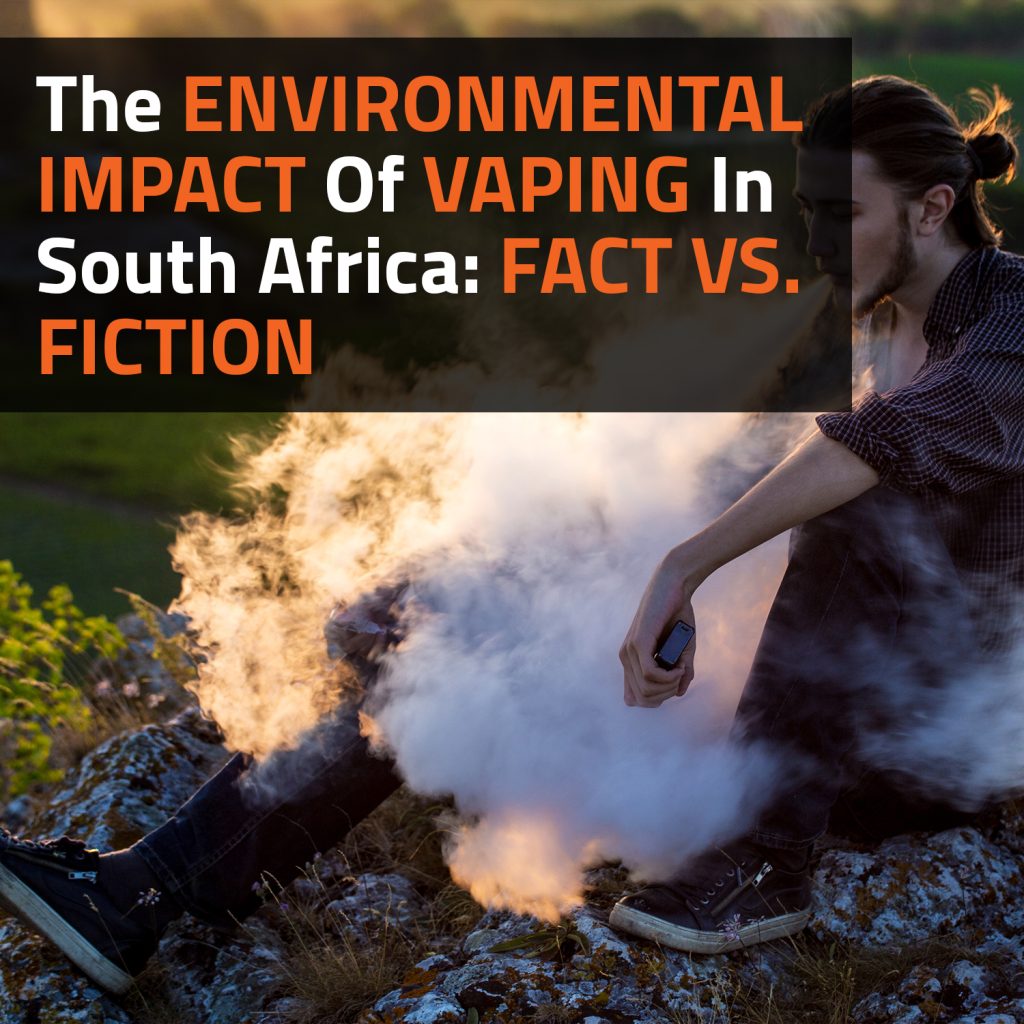The vaping industry in South Africa has surged in popularity over recent years, emerging as an alternative to traditional tobacco products. While many have discussed its health implications, the environmental impact of vaping remains an underexplored topic. With a country as diverse and ecologically sensitive as South Africa, understanding the ecological footprint of vaping is paramount. From e-waste challenges to the chemical footprint of e-liquids, the vaping industry intertwines with the environment in multifaceted ways.
Why Is There A Debate On Vaping’s Environmental Impact?
The vaping industry, especially in countries like South Africa, often finds itself under scrutiny, with critics voicing concerns about its environmental implications. But is there merit to these concerns?
Why Is Vaping Popular In South Africa?
In recent years, the streets of Johannesburg, Cape Town, and other major South African cities have seen an uptick in individuals puffing away at electronic devices.
| Health perceptions | While the jury is still out on the full health implications of vaping, many South Africans view it as a healthier pivot from traditional smoking. Unlike cigarettes, e-cigarettes don’t produce tar or many of the harmful toxins found in tobacco smoke. |
| Cost-effectiveness | In the long run, investing in a vape device might be more economical. With the rising costs of cigarettes, especially after tobacco tax hikes, vaping becomes a more financially appealing option for many. |
| Variety and personalisation | The sheer spectrum of choices is mind-boggling. From mango to mojito, traditional tobacco to blueberry muffin, vaping in SA caters to every palate. Additionally, users can customise nicotine levels, allowing a tailored experience. |
| Social allure | Vaping lounges and cafes have popped up in urban areas, creating social hubs where enthusiasts share their passion, try out new flavours, and discuss the latest devices. |
How Has The Global Conversation About Vaping Influenced South African Perceptions?
The global winds of opinion, powered by news, scientific research, and pop culture, have a considerable bearing on how South Africans perceive vaping.
- International research: As countries pour resources into researching vaping’s health impacts, South Africans keenly watch for results. These findings often become discussion points in local debates, further influencing public perception.
- Media portrayal: Internationally acclaimed shows and influencers who endorse or criticise vaping can sway local opinions. South Africans, with their robust digital connectivity, are not isolated from global trends and opinions.
- Regulatory cues: When nations like the UK or USA introduce new vaping regulations, it’s not uncommon for South African policymakers to take note, influencing local regulatory frameworks and public sentiment.
What Are The Common Misconceptions About Vaping And The Environment?
As with many emerging technologies, myths and misconceptions are bound to arise. Let’s clear the air on a few commonly held beliefs about vaping and the environment:
- “Vaping is completely green”: While it might have a smaller carbon footprint compared to traditional tobacco farming and cigarette production, vaping is not without its environmental concerns, primarily due to e-waste.
- “All parts of a vape are biodegradable”: This is far from the truth. Many components, especially the batteries and electronic elements, can take hundreds of years to decompose, if at all.
What Goes Into A Vape? Understanding Its Components
Venturing into the world of vaping without understanding its components is like diving into the deep sea without understanding your scuba gear.
What Are The Primary Materials Used In Vape Devices?
Vaping has rapidly gained traction in South Africa and globally. Integral to its rise are the specific materials that constitute these widely-used vape devices.
- Battery: Primarily composed of lithium-ion, these batteries store the energy needed to heat the atomiser. Their production and disposal come with environmental concerns, especially if not recycled properly.
- Atomiser: This metallic component heats the e-liquid, converting it into the vapour that users inhale.
- E-liquid: Contained in cartridges or tanks, this solution mainly consists of propylene glycol, vegetable glycerin, flavourings, and often nicotine. The environmental concern here is primarily the plastic cartridges and the chemical disposal.
Why Is It Important To Know What Is In Our Vapes?
Vaping has become a prevalent alternative to traditional smoking in many parts of the world. As consumers embrace this trend, understanding the components of vape devices becomes paramount. Being informed ensures safer usage and promotes a more conscious vaping community. Knowledge is empowerment. By understanding our vapes’ components:
- We gauge the environmental footprint: Recognising the materials used can help users discern their device’s environmental impact.
- Disposal becomes informed: Knowing that batteries or cartridges shouldn’t be thrown in the regular trash can lead to more responsible disposal practices.
- Making greener choices: A more informed consumer might opt for brands that use sustainable materials or have robust recycling programs.
How Do These Components Compare With Traditional Cigarettes?
The debate between traditional cigarettes and vaping has raged on for years, with each having its proponents. At the heart of this discussion is the composition of both products. A closer look reveals stark differences and some surprising similarities between the two.
- Waste: Cigarette butts, with their non-biodegradable filters, litter landscapes worldwide. Vapes, on the other hand, mainly produce e-waste, which, if not managed correctly, can be harmful.
- Production footprint: Tobacco farming is water-intensive, requires pesticides, and leads to deforestation. Vape production, while not as resource-intensive, does involve mining for metals and chemical production for e-liquids.
- Usage footprint: Every puff of a cigarette releases carbon dioxide and other greenhouse gases. Vaping does release some chemicals, but the overall greenhouse gas emissions are lower.
Is Vaping More Sustainable Than Smoking Traditional Cigarettes?
The sustainability of consumer habits has become a global focal point. In the smoking realm, questions arise surrounding the environmental footprint of vaping compared to traditional cigarettes. Delving into this comparison unveils complex dynamics and considerations.
What Is The Environmental Cost Of Producing A Single Cigarette?
Producing a single cigarette has a multifaceted environmental impact. From the extensive water usage in tobacco cultivation to the deployment of harmful pesticides and chemicals, the process takes a toll. Additionally, deforestation to create tobacco farmlands further compounds the environmental strain. Each cigarette’s journey from farm to fingertips comes with a significant environmental toll:
- Water usage: It’s estimated that producing 300 cigarettes (or 15 packs) requires about 2270 litres of water – primarily for the tobacco crop.
- Chemicals and deforestation: Tobacco farming often uses harmful pesticides. Moreover, vast tracts of forests are cleared to create tobacco farmlands, affecting biodiversity.
How Does The Production Of Vape Devices And Liquids Impact The Environment?
The production of vape devices and liquids carries its own set of environmental considerations. Mining activities to extract metals for the devices can result in habitat disruption and degradation. The manufacturing of e-liquids involves chemicals, some of which can be harmful if released into ecosystems.
Moreover, the eventual disposal of electronic vape devices, if not managed properly, contributes to the growing e-waste challenge, presenting hazards such as chemical leakage and soil contamination. While vaping sidesteps the environmental pitfalls of tobacco farming, it brings its own set of challenges:
- Mining: Metals like lithium, used in vape batteries, necessitate mining. This activity can result in habitat destruction and water pollution.
- Chemical production: E-liquids, especially their flavourings, require the synthesis of various chemicals. If not managed correctly, this could lead to environmental contamination.
Are There Recycling Initiatives For Vape Products In South Africa?
In South Africa, as the vaping trend has grown, so too has the awareness about its environmental implications. To address the potential waste from vape products, several recycling initiatives have taken root:
- Collection Points: Some vape shops and outlets have instituted collection points where users can drop off their used vape devices and cartridges.
- Recycling and Refurbishing Programs: There are programs that aim to recycle or refurbish old devices, ensuring that they don’t end up in landfills and that their components are reused.
- Awareness Campaigns: Recognising the importance of informed consumers, there have been campaigns and educational drives to make vapers aware of the environmental impact of improper disposal and the available recycling options.
However, it’s essential to note that while these initiatives are a step in the right direction, there’s still ample room for expansion and improvement. The hope is that as the industry grows, so will its commitment to sustainability and eco-friendly practices.
What Happens To Vape Waste?
You might have never given it a thought, but those nifty vape pens and cartridges have an afterlife. And sadly, it’s not always environmentally friendly. If you’re keen to puff responsibly, understanding the fate of vape waste in South Africa is a great place to start.
How Do Discarded Vape Products Affect The South African Landscape?
The impact of discarded vape products on the South African landscape mirrors challenges seen globally, but with its unique context. South Africa, with its rich biodiversity and unique ecosystems, faces particular threats from waste:
- Littering: South African streets, beaches, and parks, much like public spaces worldwide, aren’t immune to littering. Discarded vape pens and cartridges can become a common sight, adding to the existing litter problems, affecting both urban and natural landscapes.
- Contribution to E-waste: Vape devices are electronic items. When disposed of improperly, they add to the burgeoning e-waste challenge in South Africa, which is grappling with the proper management of electronic waste. E-waste not only occupies landfills but also potentially releases harmful chemicals into the environment.
- Chemical Contamination: Old or damaged vape devices and cartridges might leak residual e-liquids. These liquids can introduce chemicals to the soil and waterways, posing a threat to aquatic life and potentially contaminating groundwater sources.
Addressing these concerns requires comprehensive waste management strategies and public education campaigns to ensure vape products are disposed of responsibly. As vaping’s popularity grows, understanding and mitigating its environmental impact becomes crucial for South Africa’s sustainable future.
Why Can Vape Cartridges Be A Concern?
Vape cartridges, integral to the vaping experience, can pose unique environmental and health challenges. Here’s why they’ve become a subject of concern:
- Non-biodegradable Materials: Many cartridges are made from plastics and metals that don’t readily degrade. This means they can persist in the environment for extended periods, contributing to landfill clutter and, when not disposed of correctly, becoming pollutants in natural landscapes.
- Residual E-liquid: Cartridges often retain leftover e-liquid, even when they’re perceived as empty. If discarded improperly, this liquid can seep out. Depending on the composition of the e-liquid, this can introduce a variety of chemicals into the environment, potentially affecting both terrestrial and aquatic ecosystems.
- Volume of Waste: As vaping continues to rise in popularity, so does the sheer number of cartridges being used and discarded. This surge in volume amplifies the other concerns, turning what might be a small issue into a significant environmental challenge.
- Potential Health Hazards: Some e-liquids in vape cartridges contain nicotine and other compounds. If cartridges break or leak, there’s a risk of these substances being ingested accidentally, especially by children or pets.
Given these issues, there’s a growing emphasis on creating awareness about proper disposal and promoting the recycling or repurposing of vape cartridges. Addressing these challenges is crucial not only for the environment but also for the health and safety of communities.
Are There Effective Methods To Dispose Of Or Recycle Vape Products In South Africa?
Yes, South Africa has recognised the growing need to manage vape waste effectively, and there are several initiatives and methods in place to facilitate the proper disposal or recycling of vape products:
- Specialised E-waste Facilities: Given that vape devices have electronic components, they can be categorised under e-waste. South Africa has facilities that specialise in handling and recycling electronic waste, ensuring these devices are disposed of safely without causing environmental harm.
- Drop-off Points at Vape Shops: To promote responsible disposal, some vape shops and distributors in South Africa have instituted drop-off points where customers can return used cartridges, devices, and other vape-related waste. This initiative not only promotes recycling but also reduces the chances of these items being improperly discarded.
- Awareness Campaigns: Proper disposal starts with awareness. Several campaigns have been launched to educate the public on the environmental impact of vape waste and the importance of proper disposal methods. These campaigns often highlight the drop-off points and provide information on separating components for better recycling.
- Research and Development: Efforts are underway to develop vape products with easier recycling in mind. This includes looking into biodegradable materials for cartridges or creating devices with fewer non-recyclable parts.
- Collaboration with Environmental Organisations: Some vape companies are partnering with environmental NGOs and other organisations to ensure that their products’ end-of-life is managed responsibly. These partnerships often involve setting up wider recycling programs and educating the public about the importance of environmental stewardship.
While these methods are a step in the right direction, ongoing efforts and increased public participation are essential to ensure that the impact of vape waste on the South African landscape is minimised.
How Does Vaping Impact Indoor Environments And Air Quality?
Vaping, while being touted as a cleaner alternative to traditional smoking, still has implications for indoor environments and air quality. Let’s break down the major points of consideration:
Chemicals Released During Vaping
- Nicotine: Even though e-cigarettes might release nicotine at lesser quantities than traditional cigarettes, it is still emitted into the surrounding air when vaped.
- Propylene Glycol and Vegetable Glycerin: These are the primary base components of most e-liquids. When heated, they produce an aerosol that vapers inhale and exhale into the environment.
- Flavourings: E-liquids come in various flavours, and the specific chemical compositions of these flavourings can vary widely. While many are generally recognised as safe for ingestion, the implications of inhaling them—and of those around the vaper inhaling them—are not entirely understood.
Comparison with Traditional Cigarettes
Traditional cigarettes emit tar, carbon monoxide, and thousands of other chemicals when burned. Secondhand smoke from these cigarettes is proven to be harmful, causing various health issues, especially in non-smokers exposed to it.
In contrast, vaping does release fewer toxins. However, it’s important to note that “fewer toxins” doesn’t mean “no toxins.” There are still emissions from vaping, but they are different in nature and quantity from those of regular cigarettes. The long-term effects of inhaling vape aerosol remain under study.
Potential Health Implications for Non-Vapers
- Allergens and Irritants: Some individuals might experience reactions to the chemicals in the vapour. This can include throat or eye irritation, especially in confined spaces with poor ventilation.
- Nicotine Exposure: While the nicotine content in secondhand vapour is less than that in secondhand smoke, non-vapers are still exposed to it in an indoor environment where vaping occurs.
Recommendations for Indoor Vaping
- Ventilation: Ensuring good air circulation can help in dissipating vape aerosol more effectively.
- Designated Vaping Areas: Much like smoking, creating specific areas for vaping can help limit exposure to non-vapers.
- Awareness and Respect: It’s essential for vapers to be aware of the potential implications on others and to vape responsibly, especially in shared indoor spaces.
The Consumer’s Role: How Can Vapers Minimise Their Environmental Footprint?
Vaping, a popular alternative to traditional smoking, brings its own set of environmental challenges. As consumers, vapers have a significant role in determining the ecological impact of their choices. Adopting sustainable practices can help mitigate the environmental footprint of vaping.
Why Is It Essential For Vapers To Be Environmentally Conscious?
Vapers must be environmentally conscious for several compelling reasons:
- Environmental Impact: Vape products, if not properly discarded, can contribute to littering and electronic waste. They can end up polluting public spaces, soil, and water bodies, thus harming ecosystems.
- Chemical Leakage: Improper disposal of vape cartridges or damaged devices can result in leakage of residual e-liquids, introducing potentially harmful chemicals into the environment.
- Consumer Influence: Vapers, as consumers, wield considerable influence over the industry. By choosing eco-friendly products and demanding sustainable practices, they can drive manufacturers to adopt greener initiatives.
- Public Perception: As vaping becomes more mainstream, it’s crucial for the vaping community to present itself as responsible. Being environmentally conscious can improve the overall image and public acceptance of vaping.
- Future Generations: Being environmentally conscious is a responsibility we owe to future generations. Ensuring that our habits don’t degrade the environment means a cleaner, healthier planet for those who come after us.
By understanding and acting upon these reasons, vapers can not only enjoy their habits but also ensure that they are minimising their environmental impact.
How Can Vapers Select Eco-Friendlier Products?
Imagine you’re at a vape store, surrounded by a plethora of options. But which one is the greenest choice? Well, strap in, eco-warrior, because we’re diving deep into the green side of vaping.
- Opt for rechargeable devices: Think of it this way – every disposable vape is like a single-use plastic bottle. Not so cool, right? Rechargeable devices are like your trusty reusable water bottle, cutting down waste one puff at a time.
- Research brands: Now, this is detective work that even Sherlock would be proud of. Dive into a brand’s ethos. Are they walking the green talk? Supporting companies that prioritise sustainability is an excellent way to send a message to the industry.
- Choose refillable cartridges: If disposable cartridges are like those pesky single-serve ketchup packets, refillables are the family-sized bottle. By refilling, not only do you save money but also cut down on throwaway culture.
What Are Some Best Practices For Disposing Of Vape Waste?
Proper disposal of vape waste is pivotal in maintaining an eco-friendly environment. Vape products, comprising electronic components and potential chemical residues, pose unique disposal challenges. Addressing these concerns is essential to mitigate environmental harm and promote sustainable practices.
- Use designated drop-off points: Remember those drop-off bins at vape shops? They’re not just for decoration. They ensure your used devices get the end-of-life care they deserve.
- Separate components: It’s a bit like dissecting a frog in science class. By breaking down your vape, you make recycling processes more efficient. Metals here, plastics there, and e-waste somewhere else.
- Avoid regular trash: Picture your vape device chilling in a landfill for decades. Not the retirement plan you had in mind for it, right? Keep it out of the regular bin.
The Role Of Manufacturers And Regulations: Can They Make A Difference?
Manufacturers and regulatory bodies hold significant sway over industries, including the vaping sector. Their policies, practices, and innovations directly shape the environmental impact and public perception of vaping products. By understanding their roles and potential collaborations, we can gauge the direction the vaping industry may take, particularly in addressing environmental concerns.
How Are Vape Manufacturers Addressing Environmental Concerns?
Vape manufacturers are at the forefront of balancing consumer demands with environmental responsibility. As sustainability becomes a global priority, these companies find themselves under scrutiny. The strategies they adopt can significantly influence the environmental footprint of the vaping industry.Manufacturers are the architects of the vaping world:
- Eco-friendly materials: Forward-thinking companies are experimenting with materials that either recycle like a dream or decompose back into Mother Earth.
- Efficient production: Less waste, less energy. Manufacturing becomes an art when it’s fine-tuned to minimise environmental impact.
- Promoting recallability: Imagine getting discounts or perks for returning your used vape products. That’s the kind of recycling motivation we’re talking about!
Are There Regulations In Place In South Africa Concerning Vaping And The Environment?
In South Africa, the vaping industry is subject to a dynamic regulatory landscape. While the country has overarching waste management and environmental protection regulations, vaping-specific guidelines are still in the formative stages. These regulations encompass areas such as e-waste management, chemical controls related to e-liquids, and public awareness initiatives aimed at promoting responsible vaping habits.
- E-waste management: Vaping devices join the ranks of phones and laptops. They’re part of the e-waste family, which means specific disposal protocols.
- Chemical regulations: Those tasty e-liquids? They’re not just flavours and clouds; they have chemicals that are under the microscope of regulators.
- Public awareness: The South African government and NGOs are on a mission – to enlighten folks about the do’s and don’ts of vaping responsibly.
How Can Manufacturers And Regulators Collaborate For A Greener Vaping Future?
Collaboration between manufacturers and regulators holds the key to a more sustainable future for vaping. With the shared aim of mitigating environmental impacts, these stakeholders can jointly develop guidelines, incentives, and research initiatives. Their combined efforts can lead to standardised production practices, encouragement of eco-friendly innovations, and a more informed approach to recycling and disposal of vape products.
What Does The Future Hold For Vaping And The Environment In South Africa?
The future of vaping and its environmental implications in South Africa is a dynamic intersection of technological advancement, societal attitudes, and regulatory shifts. With the vaping industry continuously evolving, there is a potential for more sustainable product designs and efficient waste management strategies. As awareness grows and the industry matures, a synergy between manufacturers, consumers, and regulators can drive towards a future where vaping aligns more harmoniously with environmental sustainability.
Technological advancements play a pivotal role in redefining the vaping industry. As innovations surge, we’re witnessing the emergence of vape devices that are more efficient, durable, and environmentally friendly. The blend of engineering prowess and evolving consumer demands has led to devices with longer battery life, sustainable materials, and designs that prioritise recyclability, reducing the ecological footprint of vaping products. These tech-driven shifts not only enhance the user experience but also steer the industry towards a more sustainable future.
The vaping industry is ever-evolving, with researchers and manufacturers consistently pushing the boundaries of innovation to enhance user experience and address environmental concerns. On the horizon, there are promising innovations aiming to reduce the ecological footprint of vaping. These include biodegradable vape components that can decompose naturally, reducing landfill waste. Solar-powered vapes are also gaining attention, potentially decreasing the carbon footprint associated with charging devices. Furthermore, advanced recycling methods are being developed to process vape materials more effectively, ensuring that fewer components end up in landfills and more are repurposed or reused.
In the landscape of modern-day habits and industries, vaping in South Africa stands out not just for its growing popularity, but also for its environmental implications. While it offers an alternative to traditional smoking, its environmental footprint is both distinct and significant. By understanding the real impacts and sifting through the myths, both consumers and producers can make informed decisions, ensuring that the beauty and health of South Africa’s environment isn’t compromised for tomorrow.





